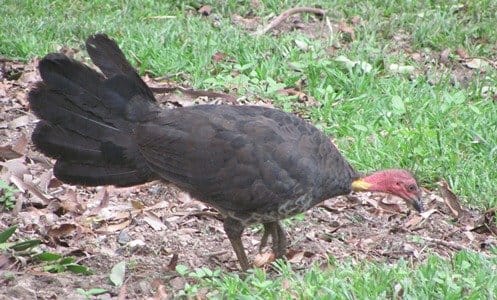
As I mentioned a few weeks ago, it was our time to go and find some new birds! We left Broome on 5th February to fly to Brisbane and arrived at 05:30am on the 6th. Due to the fact that we are not interested in city life, but more about the birdlife we headed for Nudgee Beach straight away! By 6am we had our first Australian Brush-Turkey as shown in the above photograph and the list was soon started. Our actual first bird for Queensland was a Common Myna at the airport and we were surprised that they did not seem as prolific as in Sydney. We spent the next few hours exploring the local area and then we had an afternoon rest before heading into Bunyaville Forest. We had no real plans or expectations, but with the aid of the Street Directory we just headed for a “green patch” and it proved very successful. This forest produced over two dozen Laughing Kookaburras in the late afternoon and a pair of Tawny Frogmouths. On a subsequent visit before our return to Broome we had three Pacific Baza in the first car park!
Pair of Tawny Frogmouth
Another bird that was present in several forest areas that we visited was the Forest Kingfisher with its distinct spots on its wings when in flight. We saw several of the kingfisher family whilst on our trip, including Azure Kingfisher, Red-backed Kingfisher and Sacred Kingfisher.
Forest Kingfisher
Our trip was camping based and so we planned to avoid all wet weather where possible. We did get caught out a few times, but there’s always the option of a cabin in a caravan park if it gets too nasty! It was never actually cold and the joy of waking to birds and listening to birds occasionally during the night is what we were chasing. You soon adapt to the early mornings and early nights to coincide with the wildlife!
One lovely campsite!
The culprits for our early morning wake up calls were invariably the Laughing Kookaburra at about 05:30am. There’s nothing quite like being woken up by a bird literally laughing at you!
Laughing Kookaburras with Australian Brush-Turkey in the background at a campsite
Although we generally kept inland to avoid the coastal wet weather we did venture to Toorbul in Moreton Bay. At high tide the shorebirds have a protection wall where they can roost on green lawn and feel safe. It appears to work very well and the birds were relaxed. We did have the good fortune of finding an individually marked Bar-tailed Godwit that was marked in Yalu Jiang Nature Reserve in China last April 15th and was last seen there on May 11th 2012. I expect he has done some travelling in the period from May 2012 to February 2013!
Shorebird roost at Toorbul
As we travelled around the hinterland we discovered that the Cattle Egret in that area of Queensland were with the cattle! Now that is just how it should be! Sometimes they were with horses, but that’s OK!
Cattle Egret and cattle
The hinterland produced some amazing birds and we did find it hard work looking so high into the trees to find the Catbird that continuously called and the Wompoo Fruit Dove, but the leaf litter below also produced some well-disguised birds. The scrubwrens were bountiful and the Eastern Yellow Robin soon told all the other birds that we were in the forest! The absolute highlight was when I heard leaf litter being thrown about. I soon discovered that we had our first Australian Logrunner! We had two pairs and they are incredible to watch as they throw the leaves sideways.
On one miserable wet day around Biggenden and Mount Perry we had to drive to bird and although it seemed unlikely we would see many new birds we actually did very well. Of course we did do several U-turns, but we were driving slowly on windy roads and we rarely missed out on the second chance on seeing the bird. Of course it helps if the bird is large, as with the Australian Bustard!
Australian Bustard and cattle
Dalby has been rather unlucky with wet weather recently and it was no different when we visited. All of the accommodation was taken in town by the road repair men due to the fact that a lot of the top surface has been washed away in the flooding following Cyclone Oswald before our arrival. We were planning to visit Lake Broadwater Conservation Park anyway and so we headed there and thankfully the rain eased. The Apostlebirds were drying off as we got there, so it looked promising. In fact the lake was too deep for a lot of bird species, but the track in the bush was very productive and our 200th bird after two weeks was the Red-capped Robin!
Apostlebirds drying off
On occasions you are tricked by birds, because they are not doing what you are expecting them to do! Normally we saw treecreepers doing literally that…creeping up trees, but on one occasion we had one hopping along a trail! It appeared to still be finding food, so there’s no reason why it should stick to trees!
Brown Treecreeper
Due to the weather getting wetter along the coast and in the hinterland we headed inland to Charleville and then south to Cunnumulla. We were keen to find new environments and therefore new birds. Once we got beyond Mitchell we were starting to get bored of Emu, as we saw some every few minutes! Most fathers had several juveniles with them and the recent wet years after drought had enabled the population to increase. Sadly we did see a lot of road kill and no doubt a result of people driving at night. In fact by the time we went further west to Lake Bindegolly National Park we were ignoring the Emu. 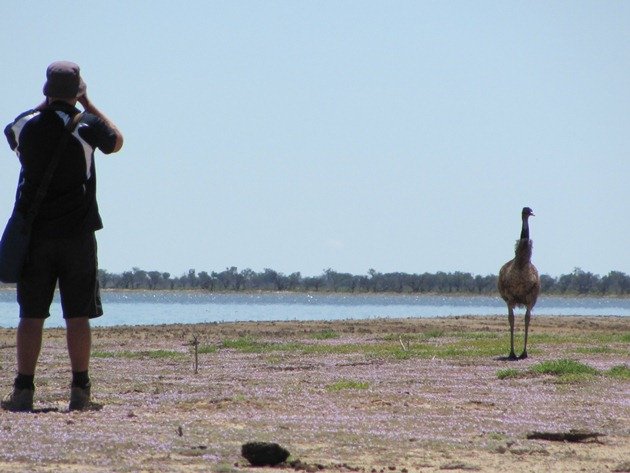
Grant ignoring Emu
Lake Bindegolly National Park is the most amazing place and I will write about it separately, but consider a place 1000kms from the coast with birds wherever you look!
Lake Bindegolly and a few birds!
As we travelled east again we often came across huge flocks of Budgerigars with a few Cockatiel amongst them. Near Bollon we came across a flock and amongst them were Crimson Chat and we had previously experienced over two dozen Orange Chat at Lake Bindegolly National Park.
Budgerigars and Cockatiel
We had heard that there were Major Mitchell Cockatoos at Eulo and we found five on the dirt strip that was a runway in the very early morning. We then found that they were even more prolific at the caravan park at St George! They are a lot paler pink than the Galah, which we saw most days in the area.
Major Mitchell Cockatoos
Of course, some of you will be eager to know about the dangers we faced in the Outback! We had a million mosquito encounters due to the previous wet weather…another good reason to head to bed early, but only two snake encounters! The most deadly snake was the Mulga Snake and there is no photograph as it was between me and the camera. It suddenly appeared behind me as I watched birds come in for an early morning drink and Grant slammed a car door and it then turned. I was not even thinking of photographing it, but how much better it would be further away. The other snake was a Carpet Python lying on the trail at Kondalilla Falls. Grant advised me that if it bit me I would not die, so I did get a photograph and then let him go forward first!
At the end of four weeks of camping and birding we had only had one day with no new bird species and we had 271 for Queensland. Actually, Grant has 272 because he had a Buff-banded Rail and a Spotted Crake in the car park at the campsite at Landsborough and after I had paid the Spotted Crake had gone, so I dipped on that one! Of the 271 bird species I had 163 new ones to add to my year list and a total of 311 now! That is 11 more than the total for 2012 and we are only in March, so we have done pretty well and there are more birds right here in Australia to see even without thinking about an overseas trip! I have hardly touched on the amazing time we had, but if you ever have the opportunity to wander at random exploring different environments looking for whatever passes your way….just do it!!!
For those of you who like statistics here’s a chart of the birds seen only in one location or in all three locations as of March 8th! This could change at any minute!


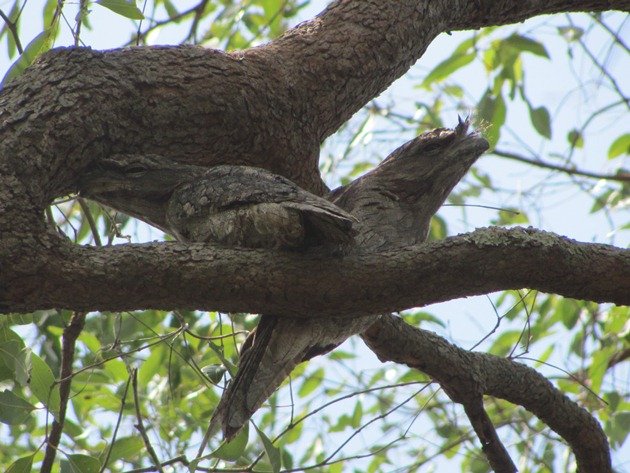
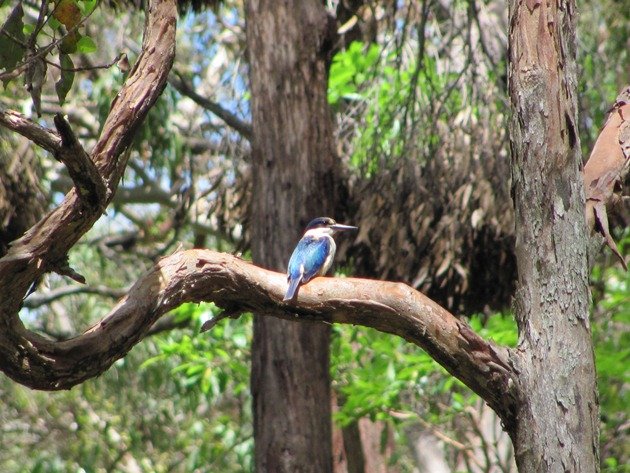
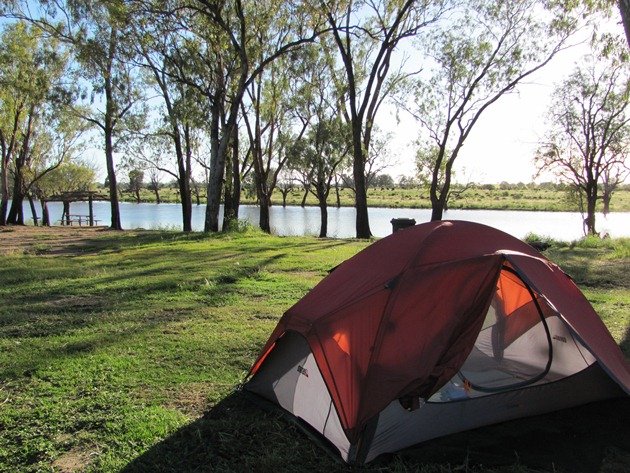
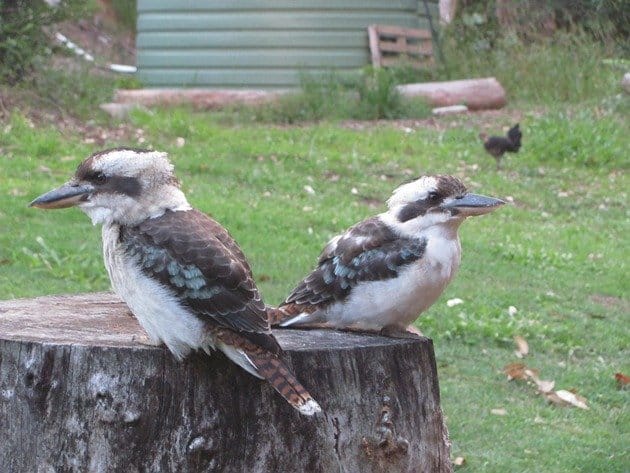
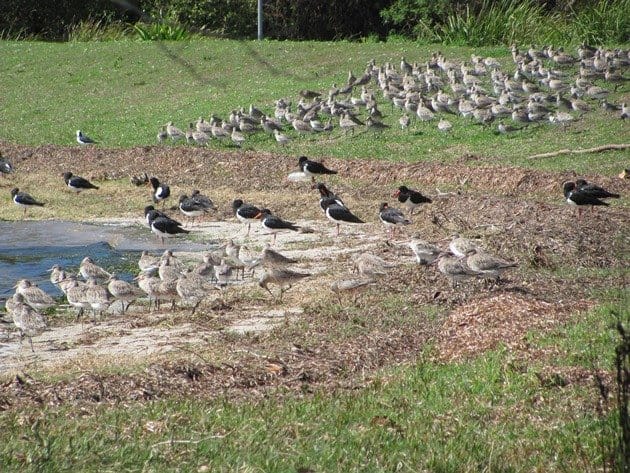
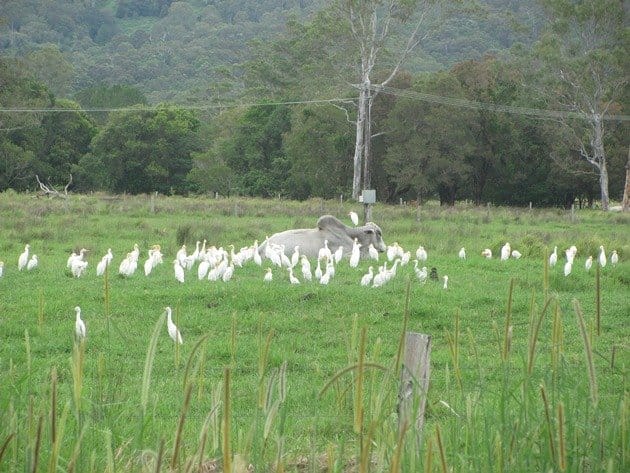
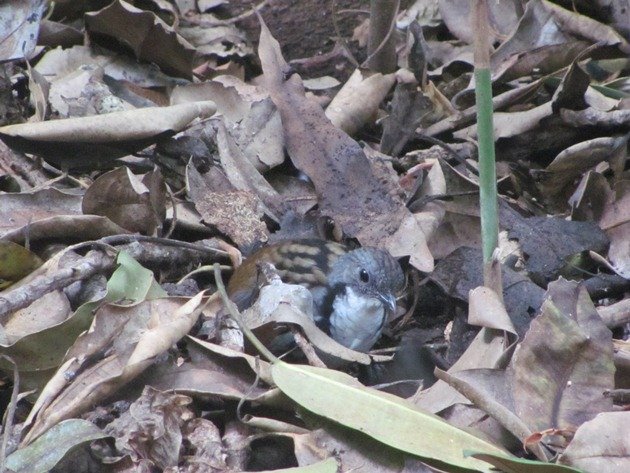
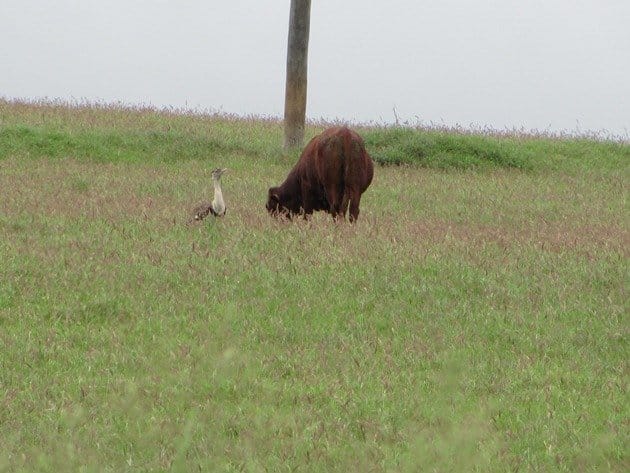
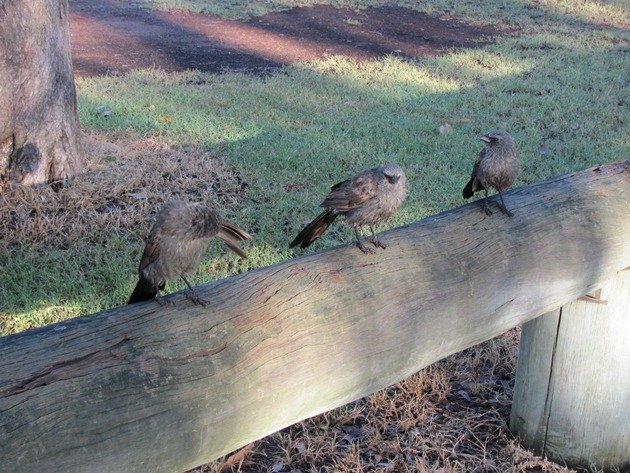
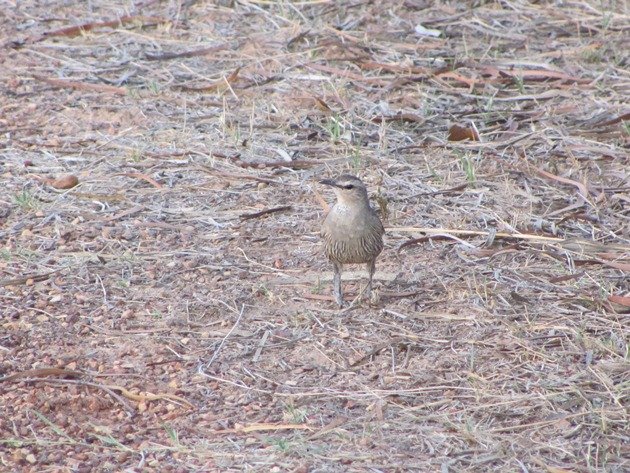
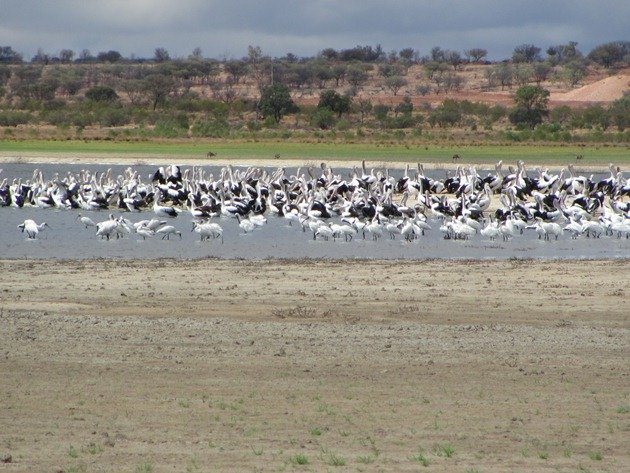
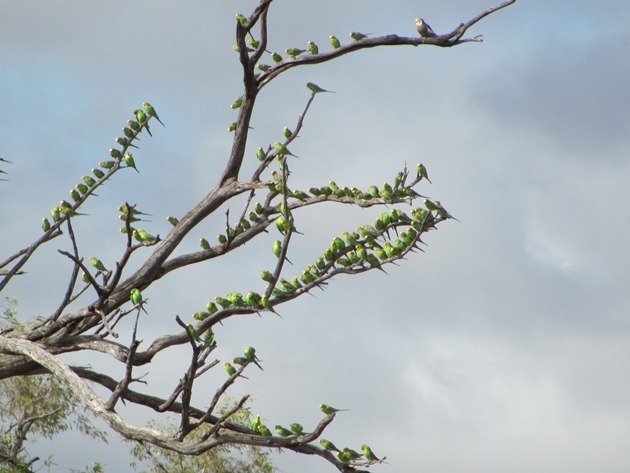
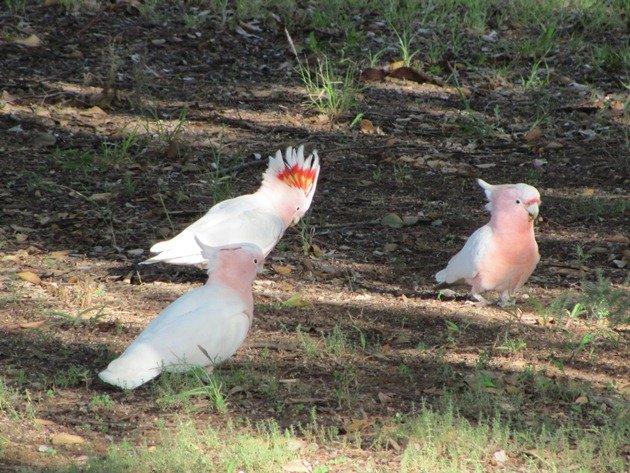
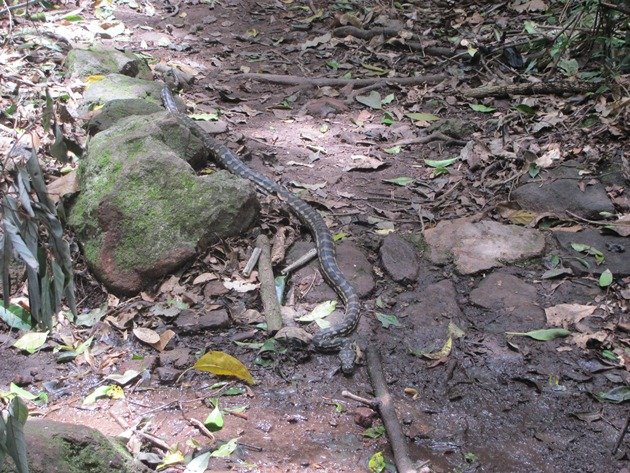
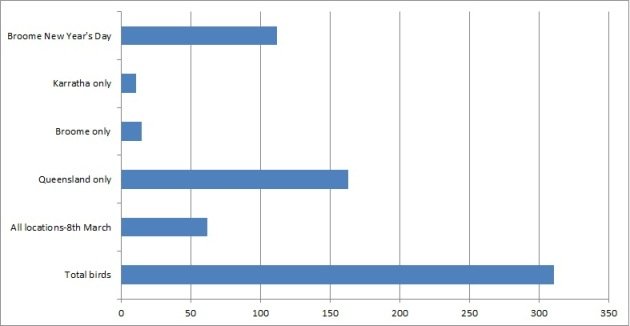











Budgies!
They are the big gaping hole on my Australia list!
I must make a bigger effort to look for them on my next vist.
Simon…you need to head inland on the east coast, but we get them on the coast here in Broome some years. Very rarely in small numbers anywhere! Good Luck! 🙂
Delightful! Loved your W. Australian perspective and can’t wait to get down under.
Clare, this is such a rich post that I almost feel as if I’m there. Too bad I’m really not, because I can’t wait to see all those birds!
Great post! What an amazing trip you had! Of all you saw, I’d most love to see the Tawny Frogmouth, the Budgerigar, and the Major Mitchell Cockatoo with that amazing crest. Great photo of Grant ignoring the Emu, too!
Thanks everyone….the birds are all there just waiting for you to jump on a plane and go for a look! 🙂